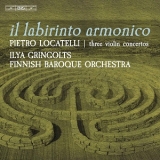 Il labirinto armonico; Pietro Locatelli: L'arte del violino - Violinkonzerte op. 3, Nr. 9, 11 & 12 (Il labirinto armonico); Ilya Gringolts, Violine & Ltg., Finnish Baroque Orchestra; 1 SACD BIS 2445; Aufnahme 01/2019, Veröffentlichung 08/01/2021 (61'49) - Rezension von Remy Franck
Il labirinto armonico; Pietro Locatelli: L'arte del violino - Violinkonzerte op. 3, Nr. 9, 11 & 12 (Il labirinto armonico); Ilya Gringolts, Violine & Ltg., Finnish Baroque Orchestra; 1 SACD BIS 2445; Aufnahme 01/2019, Veröffentlichung 08/01/2021 (61'49) - Rezension von Remy Franck
Antonio Locatellis L’arte del violino, 12 Violinkonzerte op. 3, ist ein für die Entstehungszeit, 1733, ungemein modernes Werk, das definitiv Abschied genommen hat vom Barock. In ihm vereinen sich Virtuosität und kunstvolle Gestaltung zu einem Ganzen. Locatelli ist gewissermaßen der Vorläufer von Paganini.
Man kennt davon viele Interpretationen, die seit den eleganten von I Musici auf den Markt gekommen sind, gediegene ohne Manierismen, effektvollere, solche, die vor allem durch die Verzierungskunst auffallen, aber auch betuliche und eher müde. Das Problematische an Locatellis Musik ist, dass ihr weder mit fetzigem Musizieren noch mit Samthandschuhen beizukommen ist.
Ilya Gringolts’ Aufnahme mit dem Finnischen Barockorchester wird dem Virtuosen ebenso gerecht wie den kunstvollen Verzierungen.
Der Vortrag ist durchgehend frisch, einfallsreich, detailfreudig und klar phrasiert. Dass Locatelli einen unverwechselbaren Individualstil hatte und von Zeitgenossen als ‘unerreichter Virtuose’, von Diderot sogar als ‘Apostel der neuen Musik’ tituliert wurde, wird hier deutlich. Alle Aspekte von Locatellis Klangsprache, ob lyrisch, sentimental, virtuos oder tänzerisch, treten dabei klar hervor.
Antonio Locatelli’s L’arte del violino, 12 violin concertos op. 3, is an extraordinarily modern work for its time of composition, 1733, and it has definitely taken leave of the Baroque. In it, virtuosity and artful design unite to form a whole. Locatelli is, in a sense, the forerunner of Paganini.
There are many interpretations that have come onto the market since the elegant ones by I Musici, noble ones without mannerisms, more effective ones, some that stand out above all because of the art of ornamentation, but also more calm and rather tired ones. The problem with Locatelli’s music is that it can’t be treated with either fancy music-making or velvet gloves.
Ilya Gringolts’ recording with the Finnish Baroque Orchestra does justice to the virtuoso as well as to the elaborate ornamentation.
The performance is consistently fresh, inventive, detailed and clearly phrased. It shows that Locatelli had a distinctive individual style and why he was called by contemporaries as an ‘unrivalled virtuoso’, by Diderot even as an ‘apostle of new music’. Gringolts emphasizes all aspects of Locatelli’s tonal language, whether lyrical, sentimental, virtuosic or dance-like.
























